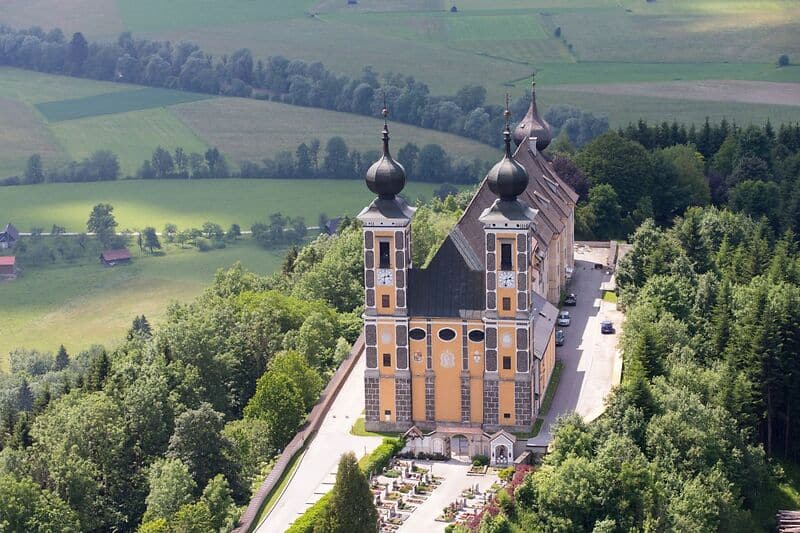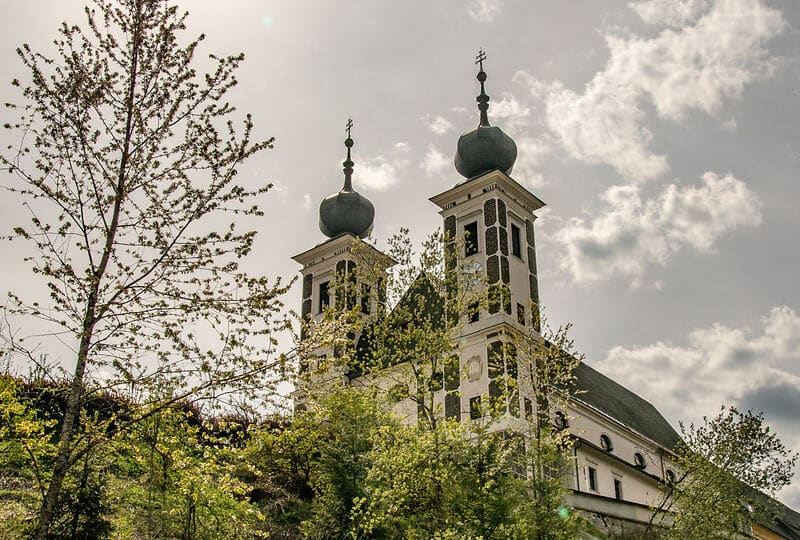Sie sind hier: Home > Parishes > Parish Frauenberg an der Enns > History and art
History and art
Here you will find information about the history of our parish
Around 6 km west of Admont, on the left bank of the Enns, rises a wooded mountain, which at its highest point, 130 metres above the valley floor, is home to the Frauenberg parish and pilgrimage church, visible from afar. The "Kulm-Berg" was owned early on by the Benedictine monastery of Admont, founded in 1074. The beginnings of the Marian pilgrimage are largely shrouded in history. An old tradition, only recorded in writing in the 17th century, describes its origins: in the spring of 1404, when the Enns was once again in flood, it carried a wooden carved statue of the Virgin Mary on its waters, which got caught in the undergrowth at the foot of the Kulm. A light phenomenon the following night, the Saturday before the second Sunday after Easter, led to the statue being found. The abbot and the members of the convent of Admont carried the statue to the collegiate church, but it had disappeared the next day and was found again at the foot of the Kulm. This was repeated a second and a third time, so that it was seen as a sign from God. Abbot Hartnid Gleusser of Admont initially built a wooden chapel for the statue of the Virgin Mary at the summit of Mount Kulm, which soon proved to be too small and was therefore replaced by a larger stone church.
In 1410, the church on the Kulm was first mentioned in a document when the foundation stone was laid for the new Gothic building. In 1420, the name Unser Frawnperg appears for the first time. In 1423, Abbot Georg Lueger founded a Corpus Christi brotherhood at the pilgrimage church, the choir of which was completed and consecrated in this year. In the first half of the 15th century, the church was redesigned under Abbot Andreas von Stettheim and rededicated on 5 August 1447 by the Bishop of Lavant, Theobald Schweinpeck, who also determined the patron saint: The Immolation of the Virgin Mary (Presentation of Mary in the Temple, commemorated on 21 November). The master builder of the first Gothic building is named as Niklas Velbacher, head builder of the Admont building lodge. In the course of Marian devotion, the influx of pilgrims soon began, whereupon miracles were also reported. The parish of Frauenberg is documented as early as the 16th century. It has been looked after by the Benedictine monks of Admont ever since.


The revitalisation of the Frauenberg pilgrimage church during the Counter-Reformation was accompanied by extensive building work. A new high altar (1648) by Christoph Paumgartner (today the case of the high altar) and a rectory were built (the windows of the 1640 building have been uncovered in the pilgrimage shop). After 1682, the nave was extended in Baroque style, the rectory significantly enlarged and a tower erected. Under the abbots Urban Weber and Adalbert Heuffler von Rasen and Hohenbühel, the place of pilgrimage largely took on its present form. The redesigned church building was consecrated on 2 July 1687. The castle-like vicarage took on its present form at this time: Inside, there are splendidly furnished rooms, some of which serve as the priest's (superior's) flat.
Abbot Antonius II von Mainersberg had the two east towers built, purchased a new bell in 1719 and built the large pilgrims' hostel (today's Caritas nursing home) in 1724. Abbey sculptor Josef Stammel created a new altar of grace in 1740. The place of pilgrimage experienced its greatest heyday in the 18th century, when up to 60,000 pilgrims were counted annually.
Under Josephinism, the pilgrimage church did not have to be closed like many others, as it also served as a parish church. In 1865, some members of the Admont convent temporarily lived in the rectory, as the monastery had been badly damaged by a fire and had become uninhabitable. During the National Socialist era, the pilgrimage was cancelled. A group from the Rosenberg staff planned to move into the vicarage as their quarters.
After the end of the war, pilgrimages to the Frauenberg took place again. The church was restored under Admont Abbot Bonifaz Zölß. In 1968, the vicarage was converted into an educational centre, which had to be closed in 1996 due to construction defects. The vicarage was then extensively rebuilt under Abbot Benedikt Schlömicher according to historical aspects. A pilgrimage shop and the parish secretariat were built on the ground floor.
From January 2013 to December 2014, the interior of the church was extensively restored on behalf of the Abbot of the Benedictine Abbey of Admont during the tenure of Fr Winfried Schwab. The total budget was 3 million euros. Among other things, a floor sonar was installed, which brought to light a known but not exactly located priest's grave in front of the pulpit. In addition to the altars, frescoes and pews, the baroque organ was also restored. The reopening of the church was celebrated on 7 December 2014 by the Bishop of the Graz-Seckau diocese, Egon Kapellari. The term of office of the current superior and parish priest of Frauenberg, Fr Maximilian Schiefermüller, began in September 2015. The parish of Frauenberg now forms a parish association with Ardning and the parish of Hall bei Admont. In 2016, in the Holy Year of Mercy, a Holy Door was opened in Frauenberg and three bells were added to the existing five-part peal. Logging work was carried out around the church, a new Marian chapel was built in the "intercession garden" and some rooms in the baroque vicarage were renovated. From April to October 2018, the church underwent a thorough exterior renovation, restoring the baroque, cream-coloured façade. The work was completed with the consecration of the "Linzer Bell" by the Abbot of Admont.
An earthquake on 20 January 2021 with a magnitude of 4.5 and an epicentre in the immediate vicinity of the church caused damage to the vicarage; windows were broken and some ceiling paintings cracked.
In 2021, the interior of the church was enriched with a new altar for celebrations and an ambo. These replaced the previous temporary structures. Both objects were created by master stonemason Gerhard Fraundorfer, the master craftsman of St Mary's Cathedral in Linz. Black, Spanish limestone was used, which blends harmoniously into the interior and picks up on the shapes of the room in its design. Abbot Gerhard Hafner blessed the altar and ambo on 21 November 2021.

